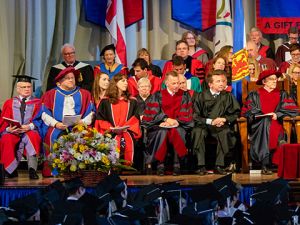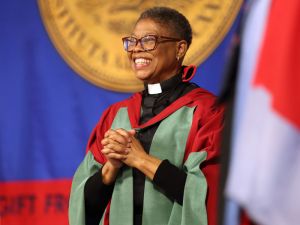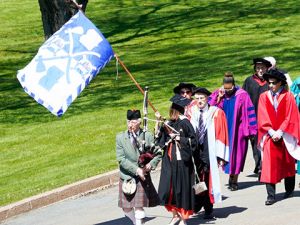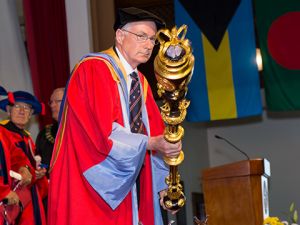The History and Meaning of the Convocation Ceremony
Convocation reaches back to the earliest days of university history when scholars and masters were summoned together for a legislative or deliberative assembly. The granting of degrees is an honour bestowed by the assembled university on those whom it wishes to distinguish for a variety of reasons.
Remembering that the university is a community and that convocation is one of its gatherings (almost its only full meeting of faculty and scholars these days), the full panoply of the university is displayed. Part of the ceremony derives its origins from the great history of the universities and part from the specific traditions of Acadia University. The convocation ceremony is rich in university tradition and ritual. It is presided over by the University Chancellor, who is the titular head of the whole university.
At Acadia,Convocation Hall is the location for all convocation ceremonies. The present one was first used in 1925 following the construction of the third University Hall. Since then, every graduate has had the opportunity to cross the same platform.
The convocation begins with the National Anthem and Prayer of Invocation. Acadia University was begun by the Baptists of Nova Scotia, and this recognizes the long tradition that distinguishes Acadia. The Convention of Atlantic Baptist Churches still appoints up to nine members to Acadia's Board of Governors. A tradition of religious freedom (as intended by those early Baptists) has prevailed at Acadia, so the prayer and benediction are intentionally inclusive, appropriate to graduates of any faith.
Convocation is full of symbolism and ritual which proclaim the glorious inheritance and traditions of Acadia University. Aspects of the ceremony harken back to medieval students who sacrificed much so that universities may grow and flourish, and the more than 180 years of students who have studied and graduated from Acadia University.

Academic dress is the distinctive dress of university scholars. This heritage has been given to us by the early university scholars for they were usually poor and looked upon with derision. Medieval society saw their interest in study and learning as idleness and indolence. Students could only afford the cheapest materials for clothing: black "stuff" was often the description. Now known as the academic gown, this was the day-to-day dress of medieval university scholars on the street and in their classes. Only a few universities continue to have students wearing academic dress in the classroom today, but when worn at convocation or at other official university functions, it should be worn with pride, as universities were established with much sacrifice and dedication by these first students.
When a university granted the honour of a degree to one of its scholars, it adopted the cape or hood of the elite, marking the borders and lining of the hood with distinguishing colours for each particular faculty and degree. Each university would keep the traditional colour (e.g. white for Arts), but invent a distinctive design for it. A person looking at the design of a gown and hood would know the specific university, faculty of study, and degree conferred.

The mortarboard is the official academic headdress of universities. It represents light appearing around a distinguished person, a "nimbus." Its purpose is to represent spiritual characters through the symbolism of light. For some in the fifth century, living persons of eminence were equipped with a square nimbus; the memory of this custom and honour is preserved in the academic mortarboard.

Baccalaureate Sunday has long been a part of University tradition, especially at Acadia University. Originally, there were two services of worship: The Baccalaureate Service, where one of the Honorary Degree recipients preached the Baccalaureate Sermon; and the "Cap and Gown" Service, where a student, elected from the graduating class, gave the address. These were amalgamated to become one service in the 1970s.
The service of worship recognizes that graduands have a greater calling beyond themselves. The University equips its students to make a contribution to society, to be prepared to give an extra effort to the betterment of humanity. The Baccalaureate Service reminds the graduating class of this honourable responsibility.

The University flag, which incorporates the Coat of Arms, was granted by the College of Arms, London, in 1974, and is carried at the head of the procession. It is the banner which proclaims the presence of the official congregation of the University and its officers.

The University mace, a gift of the graduating class of 1948, is also carried at the head of the procession. Made of turned walnut, the Mace bears intricate representations of the history, location and traditions of Acadia. Included in its design is Nova Scotia granite, amethyst, and, discretely, the figure 1948 and the motto of that class. When not in use for ceremonial occasions, the mace is displayed in the President's Office.
